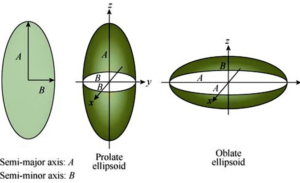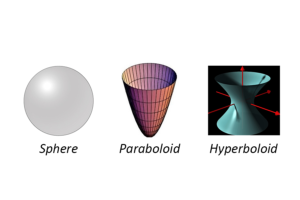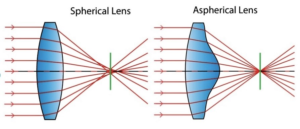What is an ASPHERIC:
Aspheric surface implies a non-spherical (viz: conic) surface with rotational symmetry about its optical axis.
The Aspheric surface profile can be represented by a mathematical relation between its sag and aperture as below:

Where:
z: Aspheric profile’s sag / depth / height
c: Curvature of the base sphere;
h: Semi-aperture of the profile;
Ai: Aspheric coefficients;
K: Conic constant K is the function of eccentricity of a conic surface (K: -e2);
K > 0 for Ellipsoid (oblate) profile rotated on its minor axis;
K = 0 for Sphere (special case of conic profile);
-1 < K < 0 for Ellipsoid (prolate) profile rotated on its major axis;
K = -1 for Paraboloid profile;
K < -1 for Hyperboloid profile.


Why an ASPHERIC is to be used in an optical system:
Optical systems employ plane, spherical, aspheric surfaces as per system needs, design specs., facilities available, budget constraints. The ultimate goal of any lens design is to transfer spherical wavefronts entering from the object side into spherical wavefronts emerging on the image side accurately, limited only by diffraction. To achieve this goal, optical designers have traditionally used spherical surfaces. A suitable design using spherical surfaces only will reduce aberrations to a tolerable level as required by practical uses of the system. Vast majority of surfaces employed in optical instrumentation spherical. Lower & medium level performance requirements are met by spherical surfaces.
The demands of end-users on optical system performance requirements are reaching near theoretical limits in terms of resolution, photonic intensity on image plane etc., with exacting system constraints in terms of foot-print, mechanical design, volume, weight etc. However, surface shapes in optical systems need not be spherical or plane only, they could be conicoidal, toroidal, cylindrical, or some more general aspheric. Over the evolution of the optical system development, it is deduced that, the performance of certain types of systems could be significantly improved by using non-spherical surfaces though at a design complexity. The demands (of resolution, photonic intensity on image plane etc., with system restrictions on foot-print, mechanical design, volume, weight etc.) can be met by deploying aspheric surfaces in the optical systems. Lens designers are familiar with the advantages of deploying aspheric surfaces in greatly improving the performance of certain optical systems, while adhering to system constraints.

The commonest use of aspherics lies in the figuring of a single surface within the system to correct a particularly recalcitrant aberration to obtain optical advantages. Hence, system designers have started investigating the use of aspherics to achieve required level of performance in the optical systems within the stipulated and anticipated constraints. With the modern state of sophistication in optical design, production, and testing techniques, number of aspheric-based systems is increasing.
Each figured surface contributes to the control of several aberration types, and the extra degrees of freedom introduced can result in: high performance systems, employing generally fewer number of elements compared to their predecessors. Due to the developments in the aspheric fabrication machinery and testing equipment, aspherics have been routinely used in high-performance optical systems and those with volume / weight / foot print restrictions internationally.
Advantages of Aspherics:
One of the major advantages of the aspheric lens is the added degrees of freedom it offers the system designer. Since aspheres remove the inherent limitations of spherical optics, the designer gains flexibility in optimizing other system parameters. In many cases, the number of elements can be reduced, increasing the potential for a more compact design. Aspheric lenses with even smaller effective focal length are capable of gathering light and focussing it to precise spot sizes, which are once again very small. The aspheric curve allows the designer greater freedom to correct mono-chromatic aberrations without introducing multi-element complexity.
The significant advantages offered by deployment of aspheric in optical and electro-optical systems include:
– Improvement of image quality
– Increase of aperture and / or field
– Reduced number of optical elements
– Reduced weight and volume budgets of optical systems
Where an ASPHERIC Profile is deployed:
There is a wide spectrum of optical instrumentation applications employing aspheric based systems. Use of aspheric in fixed focus and variable focus systems for different applications is researched and well documented. There is wide spectrum of applications employing aspheric-based optical systems at component and system levels.
Some of the areas of optical instrumentation using aspheric surfaces, where great advances have been made include: Helmet-Mounted Display systems (HMDs), Head-Up Display systems (HUDs), Wide angle optics, IR Optics for Scanners, Laser Fusion optics, Space optics, Zoom systems in consumer optics, Light-House optics for colour picture tube manufacture, TV Projection optics, X-Ray optics, Medical optics etc.
POSSIBLE R&D AREAS OF ASPHERIC-BASED OPTICAL AND ELECTRO – OPTICAL SYSTEM DEVELOPMENT.
- LASER OPTICS FOR NUCLEAR FUSION APPLICATIONS
- HIGH APERTURE COMPACT DISC OBJECTIVE SYSTEM
- WIDE FIELD ANGLE SYSTEM (RETROFOCUS LENSES)
- OPTICAL LITHOGRAPHIC OBJECTIVES
- ASPHERICS IN IR SYSTEMS
- AFOCAL TELESCOPE FOR IR OPTICS
- IR OBJECTIVES FOR SCANNER SYSTEMS
- HEAD – UP DISPLAY SYSTEMS
- HELMET MOUNTED DISPLAY (HMD) SYSTEMS
- NIGHT VISION GOGGLE OBJECTIVES
- VIRTUAL REALITY SYSTEM
- FLIGHT SIMULATOR FOR PILOT TRAINING
- LIGHT HOUSE OPTICS FOR COLOUR PICTURE TUBE MANUFACTURE
- SYSTEMS FOR OPTICAL DATA STORAGE
- TV PROJECTION OPTICS
- CATHODE RAY TUBE (CRT) PROJECTION OPTICS
- ASPHERICS FOR ZOOM SYSTEMS IN CONSUMER OPTICS & MOVIE CAMERAS
- X-RAY OPTICS
- PROGRESSIVE LENSES
- LOW – VISION AIDS EMPLOYING PLASTIC ASPHERIC LENSES
NEW APPLICATIONS OF ASPHERIC – BASED OPTICAL SYSTEMS
Recent developments in areas where the laser diodes and plastic aspheric lenses are used include:Reprographics; Bar code scanning; Fibre optic communication; Laser disk recording; Medical optics; Automobile / transport industry; Environmental optics; Entertainment optics; Security and monitoring etc. The application areas mentioned as above constitute only a fraction of entire gamut of aspheric based optical instrumentation.
